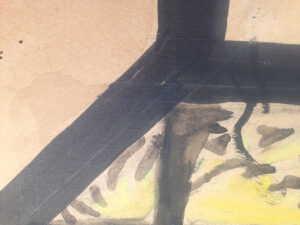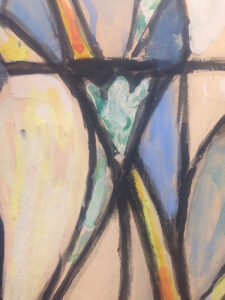Stop by the Jackson Homestead in Historic Newton before the end of July to catch the “Charles J. Connick: Adventurer in Light and Color” exhibition. It features drawings, photos, studies, and stained glass works by Charles J. Connick a prominent stained glass artist from Newton, Massachusetts. Included in the exhibit are several reproductions of drawings held by MIT Libraries as well as a stained glass window (Sir Bors Succours the Maid) from the Libraries’ collections. For more information about the Charles J. Connick Stained Glass Foundation Collection held at MIT, visit our Special Collections page or watch the video at TechTV.
The exhibition features the cartoon, or full-size study for a work in another medium, shown here. This design was executed in pencil and gouache and later realized in stained glass in 1939 for the Newtonville Public Library, which is now the Newton Senior Center. The work was inspired by the Emily Dickinson poem, “There is no Frigate Like a Book.” For more information about this image, please visit the Charles J. Connick image collection in Dome.
For more about the work of Charles J. Connick and his studio, visit the Charles J. Connick Stained Glass Foundation website and the Boston Public Library’s Charles J. Connick Gouaches: Massachusetts Flickr collection.
The following details were captured when the cartoon was in the Wunsch Conservation Lab for examination.
This post was researched written with Lorrie McAllister, Digital and Special Collections Strategist.




